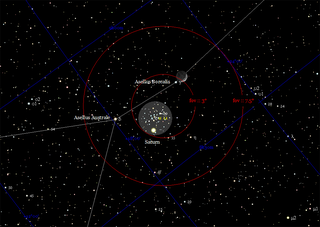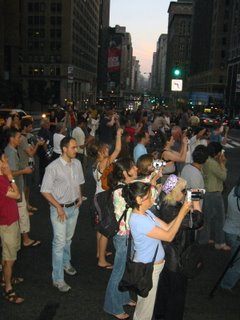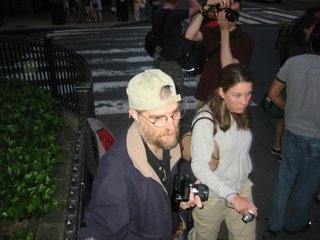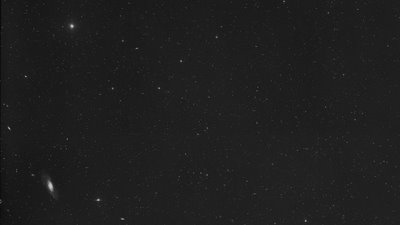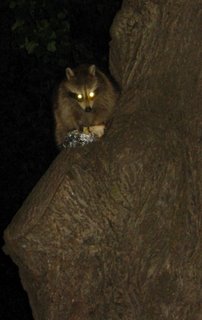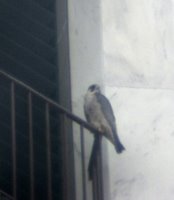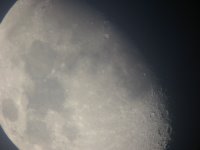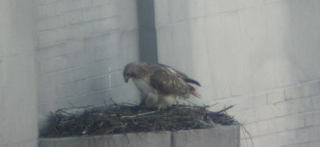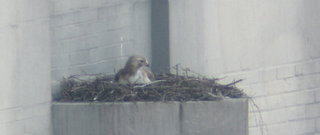

Session Name: 20060527.1800
--------------------------------------------------
Location: Eastern side of Great Lawn, Central Park, NYC
Site Classification: Urban
Dates/times: 27 May 2006, 6:00pm ~ 1:00am
Handheld Binos: Fujinon 7x50, fov 7.5°
Tripod-mounted Binos: Takahashi 22x60, fov - 2.1°
Tripod-mounted Reflector: 'Harry 6', homemade 6" F/6 newtonian
====================================
Friday
Weather History
Transparency/Seeing (1 worst - 5 best): 2
NELM: --
Conditions: Initially partly cloudy and hazy, cleared up and then became cloudy/mostly cloudy by 11pm. Transparency was poor where mag 4 stars typically stand out were very muted needing extra effort.
Observing party: Kin, Charlie, and me
Passersby: Hawaiian George, Mike, Times Up! (better than a dozen riders), a many others
---------------------------------------------------
It was a success in catching my youngest crescent to date, 19h 01m, 0.9% illuminated. The angular separation of Moon & Sun at time of sighting 10° 12' with Moon at an altitude of 7°34'. Mercury was easily visible 3° 10' SW (celestial) of Moon at mag -1.3.
After meandering a path on the web originating at Jeff's blog to a link he provided at moon watch add to that my existing interest in chasing crescents, I planned for this event. I was planning to catch the opposing crescents but the weather was not agreeable. The plan for a ~39 hour interval was:
Old crescent Moon from Carl Schurz Park prior to sunrise on Friday, 26 May 2006. Estimated a sight window 05:15 ~ 05:30. Unattempted. I awoke around 04:30am looked out the window seeing fog to the east and a very poor horizon over NJ to the west.
Young crescent Moon from the Great Lawn, Central Park just after sunset on Saturday, 27 May 2006. Estimated sighting window 20:15 ~ 20:30. Successful. Charlie & I met on the east side of the Great Lawn, just north of softball Field #2, around 6:30pm. We set up did a brief stint of solar observing seeing two groups of couple spots each. Then we waited.
Charlie caught the crescent first at 20:26 where it was 7°34' in altitude. He found a little more north on the horizon than I was looking, pretty much close to where he expected it. I had thought it would be closer to the Beresford, a building projecting off the horizon that we watched Sun set into. It may have been minutes earlier, say 3 or 4 minutes when we saw Mercury. In fact, Mercury would disappear behind the northern tower of the apartment building and reappear before we saw the crescent. I estimate the angular width of the tower to be ~0.75° ~1.0°.
Once spotted and the impression of what is to be seen the crescent was easy to see in all the binoculars. Even passers by had a look. After suggesting that they relax their gaze and look for a faintly illuminated, thin-lipped smile all saw it clearly. Charlie would describe the crescent as lumpy, and I saw it as extremely thin and uneven along the southeastern limb. Throughout my observation most of my attention was directed at the northern horn.
I want to say that I saw the crescent naked eye but do not share it with Charlie or Kin. I can't find the note in the Palm that timestamps when I recorded it. It was maybe 10 minutes later when it was tucked in a nook formed by roof of another apartment building to the north and the foreground tree in the park. The crescent was not cleanly resolved but a brightening arc which appeared brighter on the northern side. It was very difficult with Moon slightly contrasting with a horizon sky. Was this my desire to see it naked eye? I asked Charlie if he could see it and he stood right in front of me. I pointed out where to look which he found quickly but couldn't make out Moon. Later Kin came by. He saw the crescent from West 10th St. in binoculars but not naked eye.
After this we moved up to TotL proper. The sky was not nearly as good as it had been the past couple outings we had earlier in the week. Clouds would be a bother to search for any faint DSOs and it seemed like we were showing of Saturn and Jupiter to many persons that came and stopped.
Time's Up stopped by on their monthly midnight run.
Having the 6" I thought that M106 would surely fold to the bigger glass. Guess not and I remain perplexed. Absolutely in the starfield and can see this *bright* galaxy. I went to confirm that I could see M63, M94, M64 but the clouds kept moving in. I struggled with the clouds in UMa as well but there were periods where the field was clear. Oh well, sort of reminds me of the 73p Schwass - what was that called. (Sort of a non-event for me.)
Well I 'm glad for the crescent sighting and am off to the
circus today with the family.
